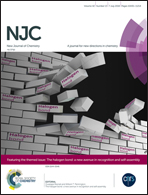Microwave assisted poly(3,4-ethylenedioxythiophene)–reduced graphene oxide nanocomposite supported Pt as durable electrocatalyst for polymer electrolyte fuel cells
Abstract
Mixed ionic-electronic conductors (MIECs) were explored for various applications due to their ionic and electronic species as separate charge carriers. MIECs have received considerable focus for polymer electrolyte fuel cell (PEFC) electrodes, electrocatalytic reactors, and gas separating membranes. Among MIECs, combinations of conducting polymers on highly conducting graphitic carbon nanostructures are particularly attractive because of their catalytic properties, electrochemical stability, and versatility for implementing various applications. In this regard, an optimum composition of a conducting polymer poly(3,4-ethylenedioxythiophene) (PEDOT) on reduced graphene oxide (rGO) supported platinum improved fuel cell performance and long-term durability. PEDOT was prepared by a micelle-mediated reverse-micro-emulsion technique, followed by grafting it over the GO. Further, Pt was deposited on PEDOT–GO using a microwave-assisted polyol method. The morphological and microstructural characteristics of electrocatalysts were investigated using different techniques. The optimum level of PEDOT embraced on rGO supported Pt retained 60% of initial ECSA and cell performance, even after 10 000 potential cycles between 1 and 1.5 V.



 Please wait while we load your content...
Please wait while we load your content...